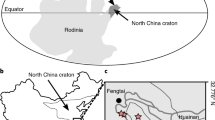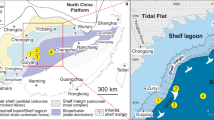Abstract
Eukaryotic life expanded during the Proterozoic eon1, 2.5 to 0.542 billion years ago, against a background of fluctuating ocean chemistry2,3,4. After about 1.8 billion years ago, the global ocean is thought to have been characterized by oxygenated surface waters, with anoxic and sulphidic waters in middle depths along productive continental margins and anoxic and iron-containing (ferruginous) deeper waters5,6,7. The spatial extent of sulphidic waters probably varied through time5,6, but this surface-to-deep redox structure is suggested to have persisted until the first Neoproterozoic glaciation about 717 million years ago8,9,10,11. Here we report an analysis of ocean redox conditions throughout the Proterozoic using new and existing iron speciation and sulphur isotope data from multiple cores and outcrops. We find a global transition from sulphidic to ferruginous mid-depth waters in the earliest Neoproterozoic, coincident with the amalgamation of the supercontinent Rodinia at low latitudes. We suggest that ferruginous conditions were initiated by an increase in the oceanic influx of highly reactive iron relative to sulphate, driven by a change in weathering regime and the uptake of sulphate by extensive continental evaporites on Rodinia. We propose that this transition essentially detoxified ocean margin settings, allowing for expanded opportunities for eukaryote diversification following a prolonged evolutionary stasis before one billion years ago.
This is a preview of subscription content, access via your institution
Access options
Subscribe to this journal
Receive 12 print issues and online access
$259.00 per year
only $21.58 per issue
Buy this article
- Purchase on Springer Link
- Instant access to full article PDF
Prices may be subject to local taxes which are calculated during checkout



Similar content being viewed by others
References
Knoll, A. H., Javaux, E. J., Hewitt, D. & Cohen, P. Eukaryotic organisms in Proterozoic oceans. Phil. Trans. R. Soc. B 361, 1023–1038 (2006).
Anbar, A. D. & Knoll, A. Proterozoic ocean chemistry and evolution: A bioinorganic bridge? Science 297, 1137–1142 (2002).
Lenton, T. M., Boyle, R. A., Poulton, S. W., Shields-Zhou, G. A. & Butterfield, N. J. Co-evolution of eukaryotes and ocean oxygenation in the Neoproterozoic era. Nature Geosci. 7, 257–265 (2014).
Mentel, M. & Martin, W. Energy metabolism among eukaryotic anaerobes in light of Proterozoic ocean chemistry. Phil. Trans. R. Soc. B 363, 2717–2729 (2008).
Poulton, S. W., Fralick, P. W. & Canfield, D. E. Spatial variability in oceanic redox structure 1.8 billion years ago. Nature Geosci. 3, 486–490 (2010).
Poulton, S. W. & Canfield, D. E. Ferruginous conditions: A dominant feature of the ocean through Earth’s history. Elements 7, 107–112 (2011).
Planavsky, N. J. et al. Widespread iron-rich conditions in the mid-Proterozoic ocean. Nature 477, 448–451 (2011).
Canfield, D. E. et al. Ferruginous conditions dominated later Neoproterozoic deep-water chemistry. Science 321, 949–952 (2008).
Dahl, T. W. et al. Molybdenum evidence for expansive sulfidic water masses in ∼750 Ma oceans. Earth Planet. Sci. Lett. 311, 264–274 (2011).
Johnston, D. T. et al. An emerging picture of Neoproterozoic ocean chemistry: Insights from the Chuar Group, Grand Canyon, USA. Earth Planet. Sci. Lett. 290, 64–73 (2010).
Thomson, D., Rainbird, R. H., Planavsky, N., Lyons, T. W. & Bekker, A. Chemostratigraphy of the Shaler Supergroup, Victoria Island, NW Canada: A record of ocean composition prior to the Cryogenian glaciations. Precambr. Res. 263, 232–245 (2015).
Canfield, D. E., Poulton, S. W. & Narbonne, G. M. Late-Neoproterozoic deep-ocean oxygenation and the rise of animal life. Science 315, 92–95 (2007).
Kendall, B. et al. Pervasive oxygenation along late Archaean ocean margins. Nature Geosci. 3, 647–652 (2010).
Canfield, D. E. A new model for Proterozoic ocean chemistry. Nature 396, 450–453 (1998).
Poulton, S. W., Fralick, P. W. & Canfield, D. E. The transition to a sulphidic ocean 1.84 billion years ago. Nature 431, 173–177 (2004).
Raiswell, R. & Canfield, D. E. The iron biogeochemical cycle past and present. Geochem. Perspect. 1, 1–2 (2012).
Poulton, S. W. & Canfield, D. E. Development of a sequential extraction procedure for iron: Implications for iron partitioning in continentally derived particulates. Chem. Geol. 214, 209–221 (2005).
Poulton, S. W. & Raiswell, R. The low-temperature geochemical cycle of iron: From continental fluxes to marine sediment deposition. Am. J. Sci. 302, 774–805 (2002).
Tang, Q. et al. Organic-walled microfossils from the early Neoproterozoic Liulaobei Formation in the Huainan region of North China and their biostratigraphic significance. Precambr. Res. 236, 157–181 (2013).
Li, Z-X., Evans, D. A. D. & Halverson, G. P. Neoproterozoic glaciations in a revised global palaeogeography from the breakup of Rodinia to the assembly of Gondwanaland. Sediment. Geol. 294, 219–232 (2013).
Spencer, C. J. et al. Proterozoic onset of crustal reworking and collisional tectonics: Reappraisal of the zircon oxygen isotope record. Geology 42, 451–454 (2014).
Shields, G. A normalised seawater strontium isotope curve: Possible implications for Neoproterozoic-Cambrian weathering rates and the further oxygenation of the Earth. eEarth 2, 35–42 (2007).
Evans, D. A. D. Proterozoic low orbital obliquity and axial-dipolar geomagnetic field from evaporite palaeolatitudes. Nature 444, 51–55 (2006).
Gorjan, P., Veevers, J. & Walter, M. Neoproterozoic sulfur-isotope variation in Australia and global implications. Precambr. Res. 100, 151–179 (2000).
Spear, N. et al. Analyses of fluid inclusions in Neoproterozoic marine halite provide oldest measurement of seawater chemistry. Geology 42, 103–106 (2014).
Ries, J. B., Fike, D. A., Pratt, L. M., Lyons, T. W. & Grotzinger, J. P. Superheavy pyrite (δ34Spyr > δ34SCAS) in the terminal Proterozoic Nama Group, southern Namibia: A consequence of low seawater sulfate at the dawn of animal life. Geology 37, 743–746 (2009).
Peng, Y. et al. Widespread contamination of carbonate-associated sulfate by present-day secondary atmospheric sulfate: Evidence from triple oxygen isotopes. Geology 10.1130/G35852.1 http://dx.doi.org/10.1130/G35852.1 (2014).
Kah, L. C., Lyons, T. W. & Frank, T. D. Low marine sulphate and protracted oxygenation of the Proterozoic biosphere. Nature 431, 834–838 (2004).
Geboy, N. J. et al. Re–Os age constraints and new observations of Proterozoic glacial deposits in the Vazante Group, Brazil. Precambr. Res. 238, 199–213 (2013).
Embley, T. M. Multiple secondary origins of the anaerobic lifestyle in eukaryotes. Phil. Trans. R. Soc. B 361, 1055–1067 (2006).
Adam, Z. R., Mogk, D. W., Skidmore, M. & Butterfield, N. J. Microfossils from the Greyson Formation, Lower Belt Supergroup: Support for early Mesoproterozoic biozonation. Geol. Soc. Am. Abstr. Programs 46, 71 (2014).
Clarkson, M., Poulton, S., Guilbaud, R. & Wood, R. Assessing the utility of Fe/Al and Fe-speciation to record water column redox conditions in carbonate-rich sediments. Chem. Geol. 382, 111–122 (2014).
Canfield, D. E., Raiswell, R., Westrich, J. T., Reaves, C. M. & Berner, R. A. The use of chromium reduction in the analysis of reduced inorganic sulfur in sediments and shales. Chem. Geol. 54, 149–155 (1986).
Goldberg, T., Shields, G. A. & Newton, R. J. Analytical constraints on the measurement of the sulfur isotopic composition and concentration of trace sulfate in phosphorites: Implications for sulfur isotope studies of carbonate and phosphate rocks. Geostand. Geoanal. Res. 35, 161–174 (2011).
Shen, Y., Knoll, A. H. & Walter, M. R. Evidence for low sulphate and anoxia in a mid-Proterozoic marine basin. Nature 423, 632–635 (2003).
Gilleaudeau, G. J. & Kah, L. C. Oceanic molybdenum drawdown by epeiric sea expansion in the Mesoproterozoic. Chem. Geol. 356, 21–37 (2013).
Sperling, E. A., Halverson, G. P., Knoll, A. H., Macdonald, F. A. & Johnston, D. T. A basin redox transect at the dawn of animal life. Earth Planet. Sci. Lett. 371–372, 143–155 (2013).
Shen, Y., Canfield, D. E. & Knoll, A. H. Middle Proterozoic ocean chemistry: Evidence from the McArthur Basin, northern Australia. Am. J. Sci. 302, 81–109 (2002).
Acknowledgements
We are grateful to P. Green, J. Davis and E. Avbelj for technical support. We thank S. Bottrell and R. Newton for constructive discussions. This work was supported by NERC through its research program ‘Long-term Co-evolution of Life and the Planet’ (Project NE/I005978/1), and the 973 program of the Ministry of Science and Technology of China (2013CB835000).
Author information
Authors and Affiliations
Contributions
R.G., S.W.P., G.A.S-Z. and M.Z. collected samples. R.G. analysed samples and interpreted data. R.G. and S.W.P. wrote the manuscript, with significant contributions from all co-authors.
Corresponding author
Ethics declarations
Competing interests
The authors declare no competing financial interests.
Supplementary information
Supplementary Information
Supplementary Information (PDF 1254 kb)
Supplementary Table 1
Supplementary Information (XLSX 71 kb)
Supplementary Table 3
Supplementary Information (XLSX 149 kb)
Rights and permissions
About this article
Cite this article
Guilbaud, R., Poulton, S., Butterfield, N. et al. A global transition to ferruginous conditions in the early Neoproterozoic oceans. Nature Geosci 8, 466–470 (2015). https://doi.org/10.1038/ngeo2434
Received:
Accepted:
Published:
Issue Date:
DOI: https://doi.org/10.1038/ngeo2434
This article is cited by
-
A phosphate-rich marine reservoir in the redox stratified Ediacaran ocean
Communications Earth & Environment (2024)
-
Micronutrient availability in Precambrian oceans controlled by greenalite formation
Nature Geoscience (2023)
-
Phylotranscriptomic insights into a Mesoproterozoic–Neoproterozoic origin and early radiation of green seaweeds (Ulvophyceae)
Nature Communications (2022)
-
Nitrogen Isotopes from the Neoproterozoic Liulaobei Formation, North China: Implications for Nitrogen Cycling and Eukaryotic Evolution
Journal of Earth Science (2022)
-
Geochemical characteristics of the Ediacaran Dengying Formation in South Qinling: implications for the dolomitization mechanism of dolomites and the terminal Ediacaran paleoenvironment
Arabian Journal of Geosciences (2021)



